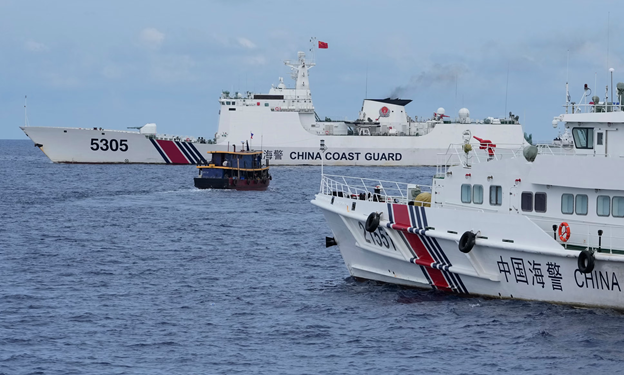Number of China Coast Guard ships spotted near Zambales – PCG

China Coast Guard vessel CCG-3304 was intercepted by the Philippine Coast Guard patrol ship BRP Cabra as it neared the Zambales coastline. Photo courtesy of the Philippine Coast Guard
The Philippine Coast Guard (PCG) spotted several China Coast Guard (CCG) vessels near Zambales and Pangasinan area Wednesday.
PCG spokesperson for the West Philippine Sea (WPS) Commodore Jay Tarriela, in a virtual press conference, said a total of five China Coast Guard (CCG) vessels were spotted in Bajo de Masinloc and near Pangasinan.
“Originally, the CCG vessels that we are only monitoring in Bajo de Masinloc is CCG 5901—of course, that’s the ‘monster ship’—CCG 3103, and CCG 3502. But this time, there is an additional CCG vessel,” Tarriela added.
“This is the new CCG vessel (5303) na napadagdag sa Bajo de Masinloc. So in total, there are now four CCG vessels in Bajo de Masinloc,” he added.
CCG 5901 or the monster ship was located 134 nautical miles (NM) off the coast of Pundaquit, Zambales. CCG 3103 was monitored 103 NM from Palauig. CCG 5303 134 NM was seen from Pundaquit. Meanwhile, CCG 3502 was spotted 156 NM from Pundaquit.
Aside from these four, another Chinese ship, CCG 3304 was spotted 43 NM from Bolinao, Pangasinan. PCG vessel BRP Cabra was shadowing the Chinese ship near the Philippine land, according to Tarriela.
Tarriela said PCG commandant Admiral Ronnie Gil Gavan has ordered an aircraft to monitor these Chinese vessels.
“The commandant of the PCG Admiral Ronnie Gil Gavan has also directed the Coast Guard aircraft to proceed to Pangasinan and also in Zambales to monitor the illegal presence of these five CCG vessels,” he added.
Meanwhile, Tarriela said China’s fisheries research ship, Lan Hai 101, which was previously spotted sailing the Philippines’ archipelagic waters via the Sulu Sea, turned off its automatic identification system (AIS) at around 7 a.m. on Wednesday.
“Based on the dark vessel detection, at around 1100 this morning, ang distance na niya is 62 nautical miles off the coast of Babuyan Island,” Tarriela said.
“It just goes to show na itong China fishery vessel na ito is going northwards. There is a possibility na pabalik na siya ng China kung bakit trinaverse niya itong western seaboard natin,” he added.
For Tarriela, it was “suspicious” for Lan Hai 101, one of China’s largest fisheries research vessels, to move within the 24 nautical miles contiguous zone of the Philippines.
On Tuesday, Philippine Navy spokesperson for WPS Rear Admiral Roy Vincent Trinidad said Lan Hai 101 complied with protocols while sailing through the country’s archipelagic waters in the Sulu Sea.
Trinidad said the Chinese ship chose to traverse the Sulu Sea to avoid bad weather west of Palawan.
Chinese Foreign Ministry spokesperson Guo Jiakun earlier defended the presence of their vessels in the Philippines’ EEZ.
Let me reiterate that China’s sovereignty and rights and interests in the South China Sea were established in the long course of history, and are solidly grounded in history and the law and compliant with the international law and practice,” the official said.
Guo maintained the CCG “conducts patrols and law enforcement activities in relevant waters in accordance with the law, which is fully justified.”
“We call on the Philippines once again to immediately stop all infringement activities, provocations and false accusations, and stop all its actions that jeopardize peace and stability and complicate the situation in the South China Sea,” he added.
Tensions continue as Beijing claims almost all of the South China Sea, a conduit for more than $3 trillion of annual shipborne commerce, including parts claimed by the Philippines, Vietnam, Indonesia, Malaysia, and Brunei.
Parts of the South China Sea that fall within Philippine territory have been renamed by the government as the West Philippine Sea to reinforce the country’s claim.
The West Philippine Sea refers to the maritime areas on the western side of the Philippine archipelago including Luzon Sea and the waters around, within and adjacent to the Kalayaan Island Group and Bajo de Masinloc.
In 2016, the Permanent Court of Arbitration in the Hague ruled in favor of the Philippines over China’s claims in the South China Sea, saying that it had “no legal basis.”
Beijing has refused to recognize the decision.






